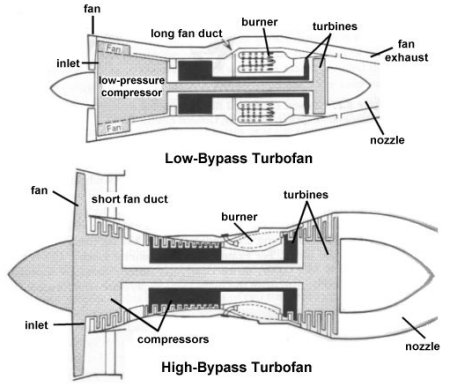There are many sources of noise from current aircraft. Turbofan engines work on the principle of sucking air into the front of the nacelle duct and pushing that same air out the back at a higher velocity. This change in momentum provides the thrust. The diameter of the engine is determined by the fan, which pulls air into the duct. This fan is a source of noise, similar to the noise caused by a propeller. The fan blades, by pushing through the air, cause noise by themselves. Once past the fan, the air is split down two different paths, the fan duct and the core duct.
First consider the flow in the fan duct. Downstream of the fan, the flow is swirling because of the spinning fan. This swirl causes loss of momentum before the air exits the nozzle so it is straightened out with a set of vanes called stators. These stators are a large source of noise as the wakes of air from fan flow slap against the stators like waves on a beach. This regular slapping takes place at the rate of blades passing by and generates a tone at what is called the blade passage frequency, or BPF. Nonuniform-ities and nonlinearities result in many higher frequency tones being produced at 2 times BPF, 3 times BPF, and so on. These tones are often associated with the piercing sound generated by some engines. Fan/ Stator interaction creates more than specific tones. The unsteadiness in the fan flow (often in the form of turbulence) interacts with the stators to create broadband noise. This is often heard as a rumbling sound.
In the core duct, the air taking this path is further compressed through a series of smaller fans called rotors. Each of these rotor stages is separated by a set of stators to straighten the flow. This is another source of rotor/stator interaction noise. The compressed air is then mixed with fuel and burned. This combustion is another source of noise. The hot, high-pressure combusted air is sent downstream into a turbine which drives the fan and the compressor rotors. Since the turbine tends to look and act like a set of stators, this is another source of noise. Finally, the core duct and the fan duct flows are exhausted into the air outside the back of the aircraft. The interaction of these jet exhausts with the surrounding air generates broadband noise called jet noise.
Jet Exhaust Noise Reduction
Jet exhaust consists of the fan stream and the core/combustion stream. The core flow stream is typically at a higher speed than the fan stream. As the two flow streams mix with each other, noise is created in the surrounding air. Of particular difficulty, the jet exhaust noise is actually created after the exhaust leaves the engine. This means that jet noise cannot be reduced where it is created, but must be addressed before the exhaust leaves the engine.
The theory of noise generation is being studied and computer codes that can simulate the theory are being developed. The final goal of this effort is to have a computer model for jet noise that will predict the source of the noise and how it is sent into the surrounding air. Theoretical understanding of jet noise is used to develop ideas for noise reduction concepts that are tested in model scale. Ideas that have already been tested or will be tested include mixer devices to combine the flows quickly, which reduce the noise generation area.
Recently, test data have shown that a 3-dB reduction in jet noise can be achieved. The final goal is to demonstrate a 6-dB reduction.
Fan Noise Reduction
In order to make progress on fan noise reduction, it is necessary to understand and be able to predict that noise. Therefore, as with jet exhaust noise, effort is being put into learning the theory of fan noise generation and developing computer codes that simulate that theory. The final goal of this effort is to have a computer code for fan noise prediction that can be verified.
A second approach uses the theoretical understanding of fan noise to develop a succession of ideas for testing, with each test providing both data upon which the computer codes are verified and results upon which the next test might be built. Fortunately, the fan thrust provides many options to explore and there are many components to vary. Besides basic geometry, there are blade-wake tailoring, boundary-layer (a thin layer of air along the duct wall that moves slower than the rest of the flow) effects, fan speed, number of blades and stators, and many more.
Recently, model test data showed that a 3-dB reduction in fan noise can be achieved. As with jet exhaust noise, the final goal is to demonstrate a 6-dB reduction.
Active Noise Control
A new approach to noise reduction is the active noise control effort. The primary principle of active noise control is to sense the noise disturbances in the engine and cancel them before they leave the engine. In effect, negative noise is made to cancel out the engine's sound waves so that no noise is heard. This is a multidisciplinary effort involving duct acoustics, controls, and actuator/sensor design

